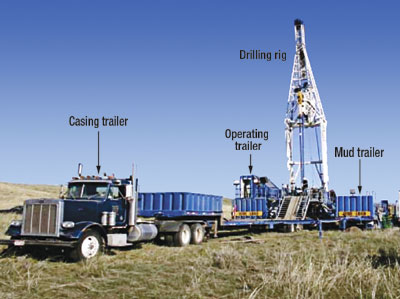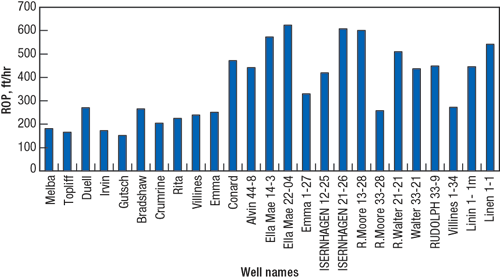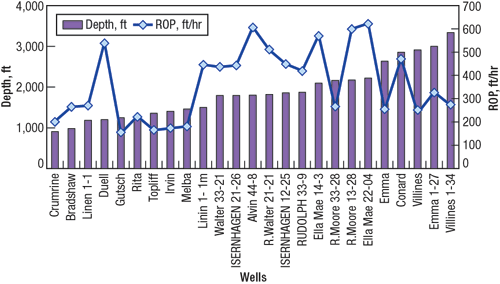|
|
|

By Petroleum Technology Transfer Council |
CT drilling takes off in Niobrara play in Colorado and Nebraska
Drilling shallow gas wells with a coiled tubing rig has improved performance while reducing costs, and use of this technology should grow rapidly.
Kent Perry, Gas Technology Institute, Chicago; Mark Malinowsky, Rosewood Resources, Dallas; and Tom Gipson and Tom Roelfs, Advanced Drilling Technologies, Yuma, Colorado
For more than a year, Rosewood Resources, Inc. (Rosewood), has employed a coiled tubing (CT) drilling rig to develop shallow Niobrara Chalk gas wells in Eastern Colorado/ Northwestern Kansas. Experience indicates that 3,000-ft wells can be drilled in less than a day (surface casing is set previously by another rig) while realizing significant cost savings compared to conventional drilling operations. For a subset of 25 wells, funding support from the Department of Energy’s (DOE’s) Microhole Technology Development program enabled the Gas Technology Institute (GTI) to become involved and provide extensive data collection and analysis, plus subjective observations.
THE NIOBRARA PLAY
Rosewood owns leases in the Niobrara Chalk play, which extends through northwestern Kansas and eastern Colorado. Gas-bearing chalk is encountered at depths from 1,000 to 3,000 ft. Niobrara gas fields are characterized by high porosity, low permeability and low reservoir pressure. Porosity ranges from 30% to 45%, with lower values found at greater depths.
Despite the high porosity, permeability is very low – from 0.01 to 0.3 millidarcies in the fairway, with microdarcy permeability found on the fringes. The Niobrara is underpressured, with geostatic pressure gradient ranges from 0.06 to 0.24 psi/ft. Thin pay zones (sometimes near water), low reservoir pressures and low in-situ formation permeability (requiring wells to be hydraulically fractured) combine to create a challenging environment for successful field development.
Individual wells are relatively low volume producers, stabilizing at 30 to 50 Mcfd, with ultimate reserves from 75 to 500 MMcf over a long producing life. Since a great multitude of wells is required to develop and produce this resource, the need for an efficient, low-cost approach to well drilling and completion provided the incentive for Rosewood to explore and employ CT drilling.
CT DRILLING RIG USED
The CT drilling data reported in this case study are from operations with a trailer-mounted rig built by Advanced Drilling Technologies (ADT). Rosewood has employed it to drill Niobrara wells for more than a year. Rig operations have continued to improve, to the point where the unit now can drill a 3,000-ft well in a single day or less.
The rig moves with four trailer loads to mitigate mobilization and transportation costs while still meeting transport limitations, Fig. 1. During transit, the rig trailer hosts the drilling rig and reel. The trailer weighs 140,000 lb and is 50 ft long by 12 ft wide. The rig contains all the equipment needed for drilling operations (including a zero-discharge mud system), has pipe handling capacity for casing up to 7-5/8 in. and can support a rotary and top drive. The CT is mounted on a reel on the rig that can handle 1- to 2-5/8-in. diameter CT. It can drill up to 5,000 ft from the surface into the formation. Mud and fluid circulation enter the tubing on the surface through a swivel mounted on the reel.
 |
Fig. 1. Integration of the four trailers, casing, operator, drilling rig and mud tank.
|
|
This CT rig has big capabilities despite its small footprint. It can run casing, and handle BHAs and logging tools, without requiring auxiliary equipment. With its derrick, traveling block and rotary table components, all required drilling processes can be performed without additional equipment. While not currently equipped with a top drive, the rig can accommodate one, if needed. CT drilling eliminates drill pipe connection time, and fewer crew members are required to operate the rig. With these capabilities, the casing time is cut very short, and running casing can be easily handled by three staff members of the rig.
CT DRILLING PERFORMANCE
Several significant drilling performance factors are affected by use of the CT unit, and in most cases, these factors show improvement. What follows are summations of activity relevant to these factors.
Rate of penetration. Among the wells drilled, the average ROP (Fig. 2) varied between 150 and 600 ft/hour. In this chart, the wells are arranged in the order drilled. The lack of relationship between ROP and the depth of wells is suggested in Fig. 3, and a clear pattern of increasing ROP over time shows a definite learning curve. For the majority of these wells, ROP values between 300 and 623 ft/hr were measured, as shown in the plot.
 |
Fig. 2. ROP of wells drilled with Microhole coiled tubing rig.
|
|
 |
Fig. 3. ROP and depth of Rosewood’s Niobrara wells.
|
|
Rig time. The expected, general relationship between well depth and total rig time is shown in Fig. 4. It must be stressed that well depths of 2,500 to 3,000 ft are being drilled, cased, logged and cemented in one day (surface casing is set previously by another rig). Of that time, less than 25% is required for drilling, itself. Very high ROPs have been achieved by experimenting with bit-downhole motor combinations, and by fully utilizing the advantages of CT drilling. Drilling rates as high as 500 ft/hour have been realized, with the average ROP/ well in the 400 ft/hr range. This rate and other rig efficiencies allowed the drilling of a 2,850-ft well in 19 hr, total time.
 |
Fig. 4. Total rig time (in hours) versus well depth.
|
|
Hole quality, cement and formation damage. Fast drilling achieves excellent hole quality. All the wells drilled have resulted in a gauge hole with very little deviation (1° to 2°). This enables good cement job quality and well-bonded cement. Both the rapid penetration rate through the pay zone, and the lack of any pressure surges caused by conventional drilling pipe connections, help to mitigate fluid loss and, therefore, formation damage in the under-pressured Niobrara.
Environmental. The rig has the capability to drill a well with zero discharge of any fluid or other materials, if required. The small rig size and efficiency of drilling, coupled with the zero discharge capability, enables drilling in sensitive areas with little or no site disturbance.
Safety. This CT rig significantly reduces drill pipe handling and has less equipment to mobilize. All of this creates a much safer operating environment, which is more important than ever when experienced roughnecks are difficult to find.
POTENTIAL FUTURE IMPACT IN US
Presently, CT drilling represents less than 1% of US activity. A recent analysis by GTI shows that initial penetration in the US market will involve vertical wells ranging from 0 to 5,000 ft, followed by horizontals. After 2010, with additional technology development, CT drilling will spread to the 5,000-10,000-ft range. By 2025, CT drilling will represent 28% of wells in the 0-5,000-ft range, and 19% of the wells in the 5,000-10,000-ft range.
Based upon an average 25% reduction in costs compared to conventional drilling, annual savings reach a level over $6 billion by 2025. It should be noted that CT drilling with today’s technology does not apply to all areas. With this lower cost, gas resources that would not have been economic with conventional methods will be developed. Assuming current technology, GTI estimates that about 11 Tcf of non-conventional gas at depths to 5,000 ft could be economically recovered from the US natural gas resource base. An essentially equal volume of conventional gas, half from new fields and half from reserve appreciation, could be recovered. 
ACKNOWLEDGEMENT
The detailed data collection for, and analysis of, this CT rig deployment in the Niobrara would not have been possible without funding support from the Department of Energy’s Microhole Technology Development R&D program. Further details about DOE’s program can be found online at www.microtech.thepttc.org/.
THE AUTHORS
|
| |
Kent Perry is director, Exploration & Production Research, at the Gas Technology Institute in Des Plaines, Illinois. His past experience includes 30 years of natural gas engineering and gas production responsibilities. Mr. Perry holds a BS degree in petroleum engineering from the Colorado School of Mines. He is a member of SPE.
|
|
|
Mark Malinowsky is chief reservoir engineer for Rosewood Resources, based in Dallas, Texas, with 30 years of experience in petroleum and reservoir engineering. His responsibilities include reserve reporting and prospect reviews for oil and gas properties located throughout the US and in the Dutch North Sea. Mr. Malinowsky participates in the planning and financial modeling of all major projects. He holds BS and MS degrees in petroleum engineering from the University of Tulsa. Email: mark_malinowsky @rosewd.com
|
|
|
Tom Gipson is a consultant for Advanced Drilling Technologies in Yuma, Colorado. He is a recognized expert in coiled tubing drilling operations. He has personally built or supervised 15 coiled tubing rigs, and has personally designed and built the rig utilized within this project. Mr. Gipson has 54 years of experience, of which 40 years have been dedicated to drilling.
|
|
|
Tom Roelfs is drilling manager for Advanced Drilling Technologies. He has more than 30 years of drilling experience throughout the US Rocky Mountain region. He has been involved with field operations of the coiled tubing rig since it was first deployed in the Kansas/ Colorado area. Email: tom_roelfs@rosewd.com
|
|
|






